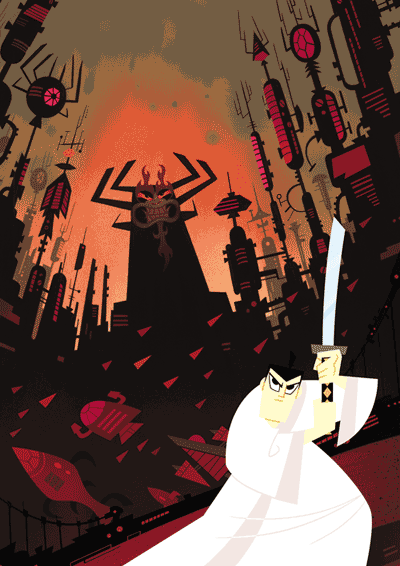Samurai Jack is a little known animated series which was broadcast on cable TV’s Cartoon Network from 2001-2004 and has gained fans since then as a cult classic. The series was noted for its highly detailed, outline-free, masking-based animation, use of splitscreens as well as for its cinematic style and pacing.

Jack (as he becomes known partway through the movie length first episode) is the son of the Japanese Emperor. When Jack is only a small child the evil shape shifter Aku escapes from his incarceration and destroys the Imperial City where Jack lives with his parents.
Spirited away to a waiting ship by his mother the Empress, Jack is sent abroad where he learns skills from the best warriors and scholars in the world with the aim of defeating Aku when he comes of age. Unfortunately he is unsuccessful on his first attempt and this establishes the premise of the show from then on as follows:
Long ago in a distant land, I Aku, the shape shifting master of darkness unleashed an unspeakable evil … but a foolish samurai warrior wielding a magic sword stepped forth to oppose me. Before the final blow was struck, I tore open a portal in time and flung him into the future where my evil is law. Now the fool seeks to return to the past and undo the future that is Aku.
The show may be set in dystopian future ruled by robots where all hope seems to be lost but when you’ve watched a few episodes you’ll realise how it must have been inspired by Clint Eastwood’s spaghetti westerns from the mid 1960’s where he plays a lone warrior roaming the land, defending poor downtrodden people.
Samurai Jack’s weakness (if it can be called that) is his tendency to help the oppressed fight Aku’s evil military industrial empire and teach the defenceless how to defend and protect themselves against marauders and Akus robot army at the expense of his goal to travel back in time and stop Aku once and for all.
If you’ve watched the opening scenes of Pixar’s Kung Fu Panda movie you’ll realise that it was inspired by Samurai Jack and included as a homage to Samurai Jack’s animator Genndy Tartakovsky. I hope the recent rumours of a Samurai Jack movie directed by JJ Abrams (Star Trek, LOST) are true.
You can buy the movie length first episode of Samurai Jack on DVD from Chaos.com
Other People’s Reviews of Samurai Jack
Jack, a time-traveling samurai warrior straight out of an Akira Kurosawa epic, is in perpetual battle with Aku, a godlike monster with crackling flames for eyebrows.
The plots are simple, elemental — in one of the new season’s episodes, for instance, Jack must conquer a tribe of half-human, half-animal hunters who have been promised a ”rain of priceless jewels” if they capture him. The half hour is one long, relentless pursuit, one that ultimately results in the tribe honoring Jack for his bravery and pluck (the series is suffused with notions of Buddhist honor and respect for honorable actions and thoughts).
Tartakovsky oversees an animation style that at first seems crudely simple: static backgrounds and simply drawn figures with a minimum of movement, much like old Hanna-Barbera-studio cartoons like ”Yogi Bear.” But where ”Yogi” and ”Huckleberry Hound” looked cheerfully cheap, ”Jack” is artful to the point of witty abstraction.
One of Tartakovsky’s most arresting strategies is to begin a scene with a single slash of color that cuts diagonally across the screen — initially, you have no idea what you’re looking at. Then, he pulls back to reveal that the slash is, say, a close-up of Jack’s mighty sword, and as the slash of metal now glides out of its scabbard, and Tartakovsky pulls back even farther, it reveals Jack’s hand withdrawing the weapon in preparation for battle.
Combine this with the lovely watercolor-style backgrounds and the show’s minimal use of dialogue (much of the time the soundtrack consists merely of the whistling forest wind or the soft chime of musical bells), and ”Samurai Jack” becomes a beautiful, sometimes devilishly scary, dream of a cartoon.
– Entertainment Weekly
The plot is strictly B movie: a young samurai is teleported by the evil wizard Aku to the distant future. So is the dialogue (“With the power of this sword, I will vanquish Aku!”). But even nonaction fans will be wowed by the art.
Creator Genndy Tartakovsky (Dexter’s Laboratory) raids the history of illustration, art and cinema with the gusto of a kid playing in an attic. He gleefully cobbles past, present and future into a supercool fantasy of classical Japanese art, Hanna-Barbera, expressionism, anime, ’60s film and ’50s modernism, just for starters. (His dystopian future city looks like hell as designed by Charles and Ray Eames.)
Best of all, in an era of chatty, hyper ‘toons, this action show knows when to stand still and shut up. Tartakovsky uses generous pauses for drama and laughs, and has no problem going 10 minutes at a stretch without dialogue.
Jack (you’ll have to watch to see how he gets the name) never dispatches an enemy with a smug, hip one-liner; he’s an appealingly naive, reserved wanderer, as might be found in one of the spaghetti westerns Tartakovsky also cites as an influence. You might call Jack a soba western. Or sashimi sci-fi. Either way, you’ll slurp it up.
– TIME

Leave a Reply